Alarm System Components
Every Alarm System Can Be Easily Customized!
There are a wide range of sensors and accessories available to be included in a burglar alarm system. This is a list of some of the more common ones. Whether you are considering a new system or adding onto an existing one, feel free to Contact Us to get a quote on these devices.
 Door/Window Contact: This is a device to arm a door or a window. This sensor will let the system know if that a door or window is opened when it is not supposed to be. This sensor can be hardwired or wireless.
Door/Window Contact: This is a device to arm a door or a window. This sensor will let the system know if that a door or window is opened when it is not supposed to be. This sensor can be hardwired or wireless.
 Shock Sensor: This contact is almost two sensors in one. It is also used to arm a door or a window. This sensor will let the system know if a door or window is opened when it is not supposed to be, but it will also sense vibrations in case the burglar decides to smash the window or glass in the door and go in that way. This sensor can be hardwired or wireless.
Shock Sensor: This contact is almost two sensors in one. It is also used to arm a door or a window. This sensor will let the system know if a door or window is opened when it is not supposed to be, but it will also sense vibrations in case the burglar decides to smash the window or glass in the door and go in that way. This sensor can be hardwired or wireless.
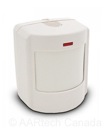 Motion Detector: This detects the infrared signature of a burglar. Pet resistant motion detectors are also available depending on the size of your pet. This sensor can be hardwired or wireless.
Motion Detector: This detects the infrared signature of a burglar. Pet resistant motion detectors are also available depending on the size of your pet. This sensor can be hardwired or wireless.
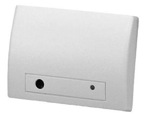 Glassbreak Detector: This sensor listens for the sound of breaking glass. It can protect a 30 by 30 foot room if the acoustics are right. It is good for protecting multiple windows in a line of sight. This sensor can be hardwired or wireless.
Glassbreak Detector: This sensor listens for the sound of breaking glass. It can protect a 30 by 30 foot room if the acoustics are right. It is good for protecting multiple windows in a line of sight. This sensor can be hardwired or wireless.
 Freeze Sensor: This sensor looks for a drop in temperature. This is useful for notifying the homeowner that their furnace has a problem when they are not home before the pipes burst. This sensor is especially popular for those individuals who are away from their homes during winter. This is a hardwired or wireless sensor.
Freeze Sensor: This sensor looks for a drop in temperature. This is useful for notifying the homeowner that their furnace has a problem when they are not home before the pipes burst. This sensor is especially popular for those individuals who are away from their homes during winter. This is a hardwired or wireless sensor.
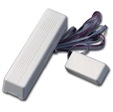 Water Sensor: This sensor looks for water. This is helpful in a basement near a water heater or boiler. It lets the homeowner know there is a problem before the basement floods completely with water. This sensor is also especially popular for those individuals who are away from their homes during winter or for vacation during the summer months. This is a hardwired or wireless sensor.
Water Sensor: This sensor looks for water. This is helpful in a basement near a water heater or boiler. It lets the homeowner know there is a problem before the basement floods completely with water. This sensor is also especially popular for those individuals who are away from their homes during winter or for vacation during the summer months. This is a hardwired or wireless sensor.
 Basement Barrier Bar: This sensor is good for basement windows that are only about 18 inches in height. If a burglar tries to enter the window, this gets “knocked out of place” and sends a signal to the alarm panel. This sensor can also be installed with a wireless transmitter if required.
Basement Barrier Bar: This sensor is good for basement windows that are only about 18 inches in height. If a burglar tries to enter the window, this gets “knocked out of place” and sends a signal to the alarm panel. This sensor can also be installed with a wireless transmitter if required.
 Smoke Detector: These detectors will be connected to the alarm system to notify the central station to contact the fire department should they go off. If we install smoke detectors, it is required by law to bring the home up to current building and fire code which states a smoke detector is required in all sleeping rooms, outside each sleeping room, and on every level of a home including the basement. All smoke detectors are required by law to be replaced every 10 years from the date of manufacture. This sensor can be hardwired or wireless.
Smoke Detector: These detectors will be connected to the alarm system to notify the central station to contact the fire department should they go off. If we install smoke detectors, it is required by law to bring the home up to current building and fire code which states a smoke detector is required in all sleeping rooms, outside each sleeping room, and on every level of a home including the basement. All smoke detectors are required by law to be replaced every 10 years from the date of manufacture. This sensor can be hardwired or wireless.
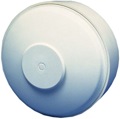 Heat Detector: This detector is good for areas where smoke detectors could cause false alarms such as the kitchen, near bathrooms, in garages and in attics. This sensor can be hardwired or wireless.
Heat Detector: This detector is good for areas where smoke detectors could cause false alarms such as the kitchen, near bathrooms, in garages and in attics. This sensor can be hardwired or wireless.
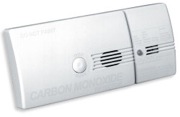 Carbon Monoxide (CO) Detector: These detectors will be connected to the alarm system to notify the central station to contact the fire department should CO levels become unsafe. This sensor, like most CO detectors, only has a lifecycle of about five years. This sensor can be hardwired or wireless.
Carbon Monoxide (CO) Detector: These detectors will be connected to the alarm system to notify the central station to contact the fire department should CO levels become unsafe. This sensor, like most CO detectors, only has a lifecycle of about five years. This sensor can be hardwired or wireless.
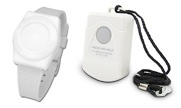 Panic Sensor/ Button: This is a device that can be activated in an emergency. It can be programmed to call the police immediately in a hold-up situation or call for an ambulance for medical emergencies. They can attach to a person’s wrist, be on a lanyard, or mounted on a wall or under a counter. This sensor can be hardwired or wireless.
Panic Sensor/ Button: This is a device that can be activated in an emergency. It can be programmed to call the police immediately in a hold-up situation or call for an ambulance for medical emergencies. They can attach to a person’s wrist, be on a lanyard, or mounted on a wall or under a counter. This sensor can be hardwired or wireless.
 4 Button Key Fob: This allows homeowners to arm and disarm their alarm system like they do their car alarms. It attaches to your keys and requires only the push of a single button to arm or disarm the system. It can also be programmed to turn on lights or open a garage door with additional hardware.
4 Button Key Fob: This allows homeowners to arm and disarm their alarm system like they do their car alarms. It attaches to your keys and requires only the push of a single button to arm or disarm the system. It can also be programmed to turn on lights or open a garage door with additional hardware.
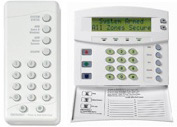 Additional Keypad: Alarm systems typically come with only a single keypad. If the homeowner would like an additional keypad, we can install one. The additional keypad can have the full functionality of the main keypad or can be a limited keypad to arm or disarm the system depending on the home or business owners needs. This device can be hardwired or wireless depending on which type of keypad is installed.
Additional Keypad: Alarm systems typically come with only a single keypad. If the homeowner would like an additional keypad, we can install one. The additional keypad can have the full functionality of the main keypad or can be a limited keypad to arm or disarm the system depending on the home or business owners needs. This device can be hardwired or wireless depending on which type of keypad is installed.
 Two-Way Voice Module: When a sensor goes into alarm on a system with traditional monitoring, the monitoring station will call the premise phone. If someone answers and can’t give the passcode or if no one answers, then the police are called to respond. With two-way voice monitoring, instead of calling the premise phone, the operator will call over a speaker/microphone unit resulting in direct two-way communication without needing to answer a phone. This prevents someone who is injured from needing to get to a phone and also as allows the central station operator to listen for someone in the house. This type of monitoring can be a life saver for those individuals with disabilities or for someone in a home invasion situation. This is a hardwired device.
Two-Way Voice Module: When a sensor goes into alarm on a system with traditional monitoring, the monitoring station will call the premise phone. If someone answers and can’t give the passcode or if no one answers, then the police are called to respond. With two-way voice monitoring, instead of calling the premise phone, the operator will call over a speaker/microphone unit resulting in direct two-way communication without needing to answer a phone. This prevents someone who is injured from needing to get to a phone and also as allows the central station operator to listen for someone in the house. This type of monitoring can be a life saver for those individuals with disabilities or for someone in a home invasion situation. This is a hardwired device.
 Cellular Backup Hardware: Many homeowners have removed their home phone or have switched to a phone service that communicated through the internet. In these situations, we recommend cellular back-up. This allows the system to transmit signals without the use of a telephone line. It is also useful as a backup in case the burglar cuts the phone lines. This is a hardwired device.
Cellular Backup Hardware: Many homeowners have removed their home phone or have switched to a phone service that communicated through the internet. In these situations, we recommend cellular back-up. This allows the system to transmit signals without the use of a telephone line. It is also useful as a backup in case the burglar cuts the phone lines. This is a hardwired device.
Home Automation Alarm.com Module: This additional circuit board can be added to your alarm control panel and will do everything that the Cellular Backup Hardware does. This device also allows a wide array of available automation upgrades to be added to your alarm system which can be controlled by your computer or any web-enabled device such as a tablet or smart phone. These could include:
- Light Control: Turn lights on and off remotely.
- Door Locks: Remotely lock or unlock your doors and even check the current status of the lock.
- Thermostat: Change the temperature you have set from any location or program it to change itself automatically whenever you leave or return to the premises.
- Garage Doors: Similar to door locks, remotely open or close your garage door and even check its status to see if it is currently open or closed on participating garage door manufacturers.
- Surveillance Cameras: Check in on your premises to see what’s going on from anywhere you are.
- Notification Services: This available add on can alert you by email or smart phone pop up when someone arms or disarms the system. changes your set temperature, or opens a door or window.
- Check out our Home Automation section for more information.
